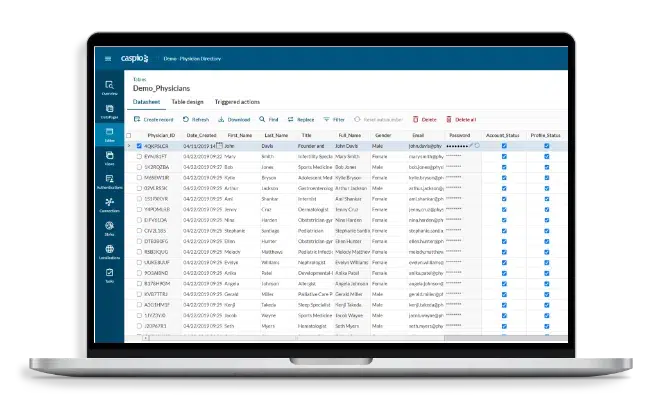Simple And Easy Open System Data Source Development Using No-Code Technology
Simple And Easy Open System Data Source Development Using No-Code Technology
Blog Article
Discover Exactly How Scalable Databases Can Be Used Without Coding to Enhance Your Organization Procedures
In today's busy company setting, the ability to manage and evaluate data successfully is extremely important. no-code. Scalable data sources, particularly when matched with no-code options, offer a transformative strategy that encourages non-technical individuals to enhance operations.
Comprehending Scalable Databases
Scalable databases are necessary for modern service operations, allowing companies to effectively handle raising volumes of information without giving up performance. These data sources are developed to adjust and grow to the altering needs of a business, making certain that they can handle larger datasets and more intricate queries as business requirements advance.
Understanding scalable databases includes identifying their 2 key kinds: upright scaling and horizontal scaling. Upright scaling, or "scaling up," entails adding even more power (CPU, RAM) to an existing web server to boost performance. Conversely, straight scaling, or "scaling out," entails adding extra servers to distribute the load, which commonly leads to higher versatility and fault tolerance.
One more important aspect is the style of scalable data sources, which can be either non-relational or relational. Relational databases, such as MySQL and PostgreSQL, are structured and use SQL for queries, while non-relational data sources, like MongoDB and Cassandra, supply even more versatility with unstructured information.
Eventually, comprehending scalable databases is vital for services intending to take advantage of information as a tactical possession, allowing them to remain competitive in a significantly data-driven atmosphere.

Benefits of No-Code Solutions
Unlocking the possibility of no-code options encourages organizations to simplify procedures and improve performance without the need for substantial programming expertise. These systems allow non-technical customers to produce, change, and handle databases easily, hence democratizing access to modern technology across groups.
One of the main advantages of no-code solutions is their speed of execution. Services can quickly deploy applications and automate procedures, significantly lowering the time invested on advancement cycles. This agility makes it possible for organizations to respond quickly to market adjustments and consumer needs, fostering an affordable side.
Furthermore, no-code systems reduce reliance on IT departments for daily jobs, enabling technological teams to concentrate on even more complicated tasks that call for specialized skills. This shift not only enhances source appropriation yet likewise promotes technology within the company.
Cost-effectiveness is another benefit, as no-code services can decrease growth and maintenance costs. By lessening the demand for coding proficiency, companies can harness the capacities of their existing workforce without the expenses of hiring additional workers.
Popular No-Code Database Devices
The surge of no-code services has led to the appearance of various data source devices that provide to businesses seeking efficiency and availability. These devices empower customers with restricted technological know-how to produce, take care of, and control data sources flawlessly.

Caspio attracts attention for its ability to develop web applications with no coding. It enables businesses to produce durable databases and deploy applications rapidly, providing to numerous industry demands. Similarly, Flair uses user-friendly user interfaces and effective data monitoring abilities, allowing organizations to build personalized applications tailored to their workflows.

Use Cases in Organization Operations
How can organizations leverage data source tools to enhance their procedures? Scalable databases provide companies with powerful abilities to handle and evaluate information without the need for considerable coding expertise. These tools can simplify numerous business procedures, eventually resulting in improved effectiveness and performance.
One popular use instance website here is customer connection monitoring (CRM) Organizations can utilize scalable data sources to track customer interactions, preferences, and feedback, enabling individualized interaction and far better service. By systematizing this info, groups can work together more efficiently and reply to consumer requirements in real-time.
Another substantial application is supply monitoring. Companies can employ no-code database devices to check stock levels, track deliveries, and projection demand. This ensures optimum stock levels, decreases waste, and lessens stockouts.
In addition, task management can take advantage of scalable databases by permitting teams to handle tasks, deadlines, and sources in a linked platform. With real-time updates and information visualization, project supervisors can make enlightened decisions.
Starting With Implementation
Applying scalable data sources in service procedures needs an organized method to make sure successful integration and application. The very first step is to carry out a complete requirements evaluation, recognizing certain organization needs, data kinds, and anticipated growth patterns. This fundamental understanding will certainly guide the option of the proper database remedy.
Following, choose an user-friendly, no-code database platform that straightens with your functional objectives. no-code. Several modern-day solutions use user-friendly interfaces, allowing non-technical customers to take care of information efficiently. After picking a system, develop a clear data architecture that describes how information will be organized, accessed, and kept
Training is critical; make certain that staff member are geared up with the necessary abilities to use the data source. Think about offering tutorials or workshops to familiarize team with the system's capabilities.
Verdict
In conclusion, the integration of scalable databases through no-code solutions presents substantial advantages for business operations. Eventually, leveraging these technologies can lead to boosted efficiency and operational effectiveness, positioning organizations for continual development in a competitive landscape.
One prominent no-code database tool is Airtable, which incorporates the capability of a spreadsheet with the power of a data source.Exactly how can companies leverage database devices to improve their procedures? Businesses can use scalable databases to track consumer interactions, preferences, Find Out More and comments, enabling personalized interaction Clicking Here and much better solution.Applying scalable databases in business operations calls for a structured technique to guarantee successful combination and application.In verdict, the assimilation of scalable data sources with no-code services presents significant benefits for business procedures.
Report this page